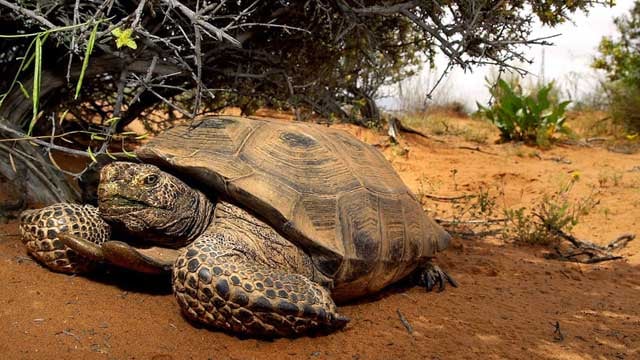DESERT TORTOISE – OH, GIVE ME A HOME!
(Bunkerville, NV) Oh give me a home on the range where my grandfather was not in a box, but his house was a hole in the rocks. If we are going to get these tortoises out of the sanctuary prisons and get them back to their natural habitat on Bundy Ranch, the time is right. The weather has cooled, the summer rains have brought green fresh tortoise feed. Within the next 30 days all the tortoises should be moved. Bundy said, “I have offered to share my ranch with the imprisoned tortoise. I do not want them to be euthanized. I decided to visit the Desert Tortoise Conservation Center (DTCC) to see the 1400 imprisoned tortoises so I could determine how big of a trailer it would take to transfer the tortoise to my ranch. I found Rainbow Blvd. traveled south, which always seems west to this old cowboy when he’s in Las Vegas. I came to the end of the street, made a three-mile detour around a large new subdivision, back to Rainbow Blvd. There I see a heavy steel gate with a badly maintained trail for a road behind it, gate locked and a sign that reads, open two days a week before 12:00 noon. My trip was in vain. I climbed up a bank of dirt to a high vantage point. I could see buildings and fencing. There it is, a tortoise prison. Urban development had sprawled across the Las Vegas valley desert floor, up the slope toward California, new houses almost outreach the tortoise sanctuary.
There was a little breeze in the air. I thought I could hear a whispering sound! Oh, give me a home on the range. Oh, oh, give me a home on the range. I do not want to live in a box any more! I want to go where my grandfathers explored. This sound could be coming from the prison at Jean, Nevada, but I don’t think so. I can hear! Oh, give me a home on the range so I can roam, before the doctor comes and sticks that needle behind my ear! Or before the bulldozer comes to build new homes! My heart sinks a little as I think of what man has done to this creature.”
Bundy said his thoughts went back to how big of a truck do we need to move the tortoise? A recent Las Vegas Review Journal article said that there are 1400 tortoises. If we are in time to save the 700 that were to be euthanized, then there should be 1400 tortoises, but LVRJ also said that the sanctuary had been taking in over 1000 tortoises every year for almost 20 years. Tortoises live over 60 years so most of those tortoises should still be alive. That’s 20,000 tortoises that need to be removed and relocated to their native habitat, but what about the 20,000’s clutches? Each mature female should have laid an 8 to 12 egg clutch and if they all hatched each year there could and should be hundreds of thousands of imprisoned critters. Oh, Bundy said he knows that they try to sex them. He means separate the Hes from the shes. He means the girls from the boys. You know, the tortoise lovers keep the tortoises from loving! Now if the ravens have not flown over the tortoise fence and ate all the juveniles and the stewards that have cared for them have not euthanized them, let’s guess, maybe 100,000 are left alive. A big double-decker cattle truck has 800 sq. ft. of floor space. We will give each tortoise 1 sq. ft. of floor space in the truck. Volunteer tortoise lovers can help carry each tortoise up the ramp into the two storied 50 ft. truck. 800 tortoises per truck divided by 100,000 tortoises, equals 121 truckloads to move to the Bundy Ranch. He said the big trucks could drive across his ranch to deliver the tortoise but the roads are not maintained because the Clark County Road Department and the BLM and Park Service wants it (the land) to go back to wilderness status. We could have tortoise lovers bring ATVs with special padded baskets to transfer tortoises to tortoise habitat where in the 1940’s, 50’s and 60’s, there were lots of cattle, thousands of sheep and abundance of happy tortoises which for thousands of years dug burrows in hard cleechie ledges along washes. These burrows are still waiting to be reshaped and made into their new winter home. WE HAVE A PROBLEM! Lots of roads and trails have Road Closed signs stating, Stay on Designated Road 10-years or $100,000 fine. We cannot risk a tortoise lover who is only trying to get an imprisoned tortoise to its native habitat before getting euthanized. The Good Samaritan will be arrested for getting off the trail and on the grass by a BLM or park service ranger (impersonating a county sheriff) given a ticket or transported to federal jail with a 10-years or $100,000 charge in federal court. That’s just too much risk upon the tortoise’s friends. Too much money, and too much of a hassle and worry to go through the US Federal court system.
WE NEED HELP – Nevada Governor Sandoval, Clark County Commissioners, and Sheriff Gillespie!








